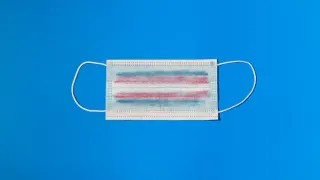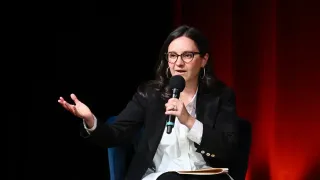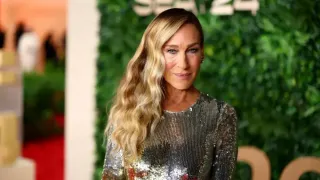October 17, 2015
Bechdel on Bechdel
Erin Blackwell READ TIME: 3 MIN.
Alison Bechdel phoned from an island off Seattle to talk about herself for 40 minutes. I humored her by tossing in the occasional question. She seemed to enjoy my conversational approach. Apparently, since becoming the toast of Broadway this year, the 55-year-old cartoonist has been deluged by interviewers, all asking her the same questions. Not sure what those are. "How does it feel to have your cartoon-autobiography of your closeted father's suicide-by-Sunshine-Bread-truck turned into a Tony Award-winning musical?" might be among them. You'll have a chance to ask her your own questions when she addresses the Jewish Community Center/SF on Wed., Oct. 21, at 7 p.m.
The first art I remember seeing by Bechdel was a line drawing of the Statue of Liberty clutching a copy of WomaNews , circa 1983, in an in-house ad in the now-defunct NYC-based radical feminist rag. I'd picked up the paper to read my own review of a Jane Chambers play and was struck by the clean, crisp rationality of the drawing. So much feminist art had been on the sloppy side. The editor shared my enthusiasm while appreciating the budding cartoonist's humility , or some such word denoting a lack of dread artistic temperament. Today, Bechdel says working for a newspaper was "really, really great training for a cartoonist."
Bechdel started drawing "as soon as I could hold a pencil." But whereas "most of us stop at a certain point," she kept going, because "I had a moderate measure of skill, and got some attention doing it." The genesis of her exquisite technique is implicit in her cartoon-memoir Fun Home (2006), which could have been called Portrait of the Artist's Father as an Exacting Escapist, or, Everything I Know About Art I Learned from a Detail Queen. Immeasurable must be Bruce's joy in the Afterworld to see his daughter turning out to be an obsessive technician who's even more maniacal, having reduced Dad's very existence to an amalgam of carefully collected and arranged details.
The surprising thing after the fun and frolic of Bechdel's long-running cartoon strip Dykes To Watch Out For (1983-2008) is the intensely twisted world of her childhood. Fun Home is short for funeral home, a business her father took over on the death of his father. Death is everywhere. She confuses creepy Charles Addams characters like Morticia with portraits of her own family. Her Dad's energetic restoration of the period home creates a diabolic atmosphere of temper tantrums erupting in a Fantasyland version of the past, where perfect existence is attainable only by the artificial and detached. Young Alison quite rightly starts to question the nature of reality, and hallucinates ectoplasmic barriers between rooms.
"I grew up in this house controlled by this secret," says Bechdel. "I had an aversion to secrecy." Aha. So many artists have the whistle-blower gene. "It's a useful gene to have." Whereas some of us might bemoan a Fate that makes us a suicide's offspring, she takes the high road. "I've had such good luck in my life. I've made room for myself. Me and this whole movement made space in the culture for it to be okay and normal." She is nonetheless somewhat surprised that her "queer and particular story touched this mainstream nerve," first in book form, now onstage.
Yet all is not perfect in this perfectionist's world. With the "cool aesthetic distance" she describes in Fun Home as her default mode, "Human relationship is not my strong suit. I struggle with intimacy." Methinks she doth protest too much. After all, she did get married in July. "I love Holly. But I'm always kind of screwing up. I wish I could be as good at real life as writing about it."






